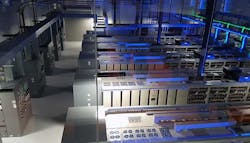GARLAND, Texas – The view from the balcony of RagingWire Data Centers’ new TX1 facility provides a glimpse into the future. Beyond the long row of generators lies 40 acres of vacant land, enough room for four more large data centers and 1 million square feet of IT space.
RagingWire is building at cloud scale, and its campus in the northern suburbs of Dallas is part of its vision to deploy wholesale data center campuses across America. The backing of parent NTT Communications provides RagingWire with the resources to compete in the cloud arms race.
But scale is just the first part of the strategy. The second is speed. In a market where hyperscale customers seek rapid delivery of IT capacity, RagingWire is retooling its data center construction operation to accelerate its deployment capabilities.
“These hyperscale guys like to see the inventory,” said Jim Leach. “We have to be able to prove we can build in six to nine months. Now everyone’s doing it, and that’s a change.”
That new construction strategy is the focus for Brian Mattson, the Vice President of Construction at RagingWire, who understands the needs of cloud-scale customers from his eight years leading the data center construction team at Microsoft.
Bigger, Faster, Everywhere
The TX1 facility marks a transition point in that process. It is the last data center built by RagingWire’s in-house construction team, with future builds featuring a mix of staff and contractors. The company has historically touted its construction expertise as the key to controlling the cost per megawatt of its data center construction.
But RagingWire is seeking to build bigger, faster and in many places at once. The Garland site is the company’s third data center campus in the U.S., along with its headquarters in Sacramento and a growing presence in Ashburn, Virginia. Between the three sites, RagingWire says it operates 1.5 million square feet of data center space and 113 megawatts (MW) of critical load.
There’s more on the way. “In the next five years, we will have a data center presence in the top six U.S. markets,” RagingWire CEO Douglas Adams told Data Center Frontier last year. That suggests that we might eventually see new campuses in Silicon Valley, Chicago and perhaps the Greater New York/New Jersey market.
Work Spaces for People as Well as Servers
The Garland campus features new design elements that will be part of RagingWire’s template going forward. This includes a flexible approach to sizing of data halls (called vaults by RagingWire) and a new cooling system using Kyoto Cooling heat wheels mounted on the data center roof.
The distinctive atrium and lobby of the RagingWire TX1 data center in Garland, Texas. (Photo: Rich Miller)
Perhaps the most distinctive element is the customer lobby, which features a large open atrium with curved white walls, meant to evoke thoughts of clouds. It’s part of RagingWire’s emphasis on the aesthetics of its data centers, which serve as work environments for humans as well as IT equipment. That’s reflected in the amenities at TX1, which include the cafeteria-style break rooms, an on-site gym, and a patio area for lunch or work. The hallways and conference rooms feature artwork, much of it created by RagingWire employees.
The visitor experience is front-of-mind. There’s a conference facility with audio/visual equipment where local business and community groups can host meetings and events. RagingWire also seeks to optimize its interiors for data center tours, featuring observation decks, catwalks and balconies that showcase the facility’s infrastructure without visitors ever entering the secure customer IT space. (For more see “Built to Show: RagingWire’s Visual Data Center”).
That doesn’t mean that everything is welcoming, and that’s part of the design as well. The entrance to the Garland campus is secured by a sturdy barrier gate with an M30-P1 rating, which means it can stop an 18-wheeler traveling 40 miles an hour. The entire campus is surrounded by an anti-climb perimeter fence, and the data center is protected by several levels of access security, including a “man trap” corridor.
As it focuses on larger wholesale deals, RagingWire is mindful of the trend towards larger data halls and has designed TX1 to offer a range of options. Data “vaults” are available in configurations from 1 megawatt to 5 megawatts.
The largest data hall is a 34,000 square foot vault that can support 5 megawatts of commissioned space.
A look at the length of the 5 megawatt, 34,000 square foot data hall inside RagingWire’s TX1 data center in Garland, Texas. (Photo: Rich Miller)
A new addition to the RagingWire design can be seen on the rooftop, which houses 74 Kyoto Cooling units to support the first 8 megawatts of capacity at TX1. Another 74 will be added when the second 8-megawatt phase is completed, for a total of 148 Kyoto units.
RagingWire is among a growing number of service providers using the Kyoto Cooling heat wheel, which eliminates the need for chillers in most operating conditions, but offers advantages over direct fresh air cooling, eliminating risk from contamination and humidity. The Kyoto system uses the exterior temperature to cool air for the data vaults, but the two airflows never meet or mix. As the wheel spins between two compartments, the ambient air cools the wheel, and then the wheel cools the supply air, which enters the data center through a cooling plenum along the back of the building.
Eliminating chillers reduces the facility’s total energy use, allowing an improved PUE (Power Usage efficiency, a key energy efficiency metric) of 1.265 for the Garland data center. The facility can run entirely on the Kyoto units when the temperature is 67 or lower, and operates with a 50-50 mix of the Kyotos and DX cooling on days when the temperature is between 68 and 90 degrees.
Some of the 74 Kyoto Cooling units mounted on the roof of the RagingWire TX1 data center in Garland, Texas. (Photo: Rich Miller)
The Garland campus is fed by two substations, and the facility is supported by RagingWire’s 2N+2 power delivery architecture, which offers a range of power resiliency configurations for customers that use an entire vault. The design is concurrently maintainable and fault tolerant.
The NTT Factor
This is the first of five data centers planned for the Garland campus, each offering at least 16 megawatts of power capacity. The buildings will be connected by a central corridor, with the office space and amenities in TX1 supporting the entire campus. RagingWire’s new construction model will allow it to move quickly to deploy new capacity.
The exterior of the RagingWire TX1 data center in Garland, the first of a planned five buildings. (Photo: RagingWire)
Cost is also a key factor in hyperscale deals, as Mattson noted in a recent Voices of the Industry column at DCF. “Construction projects that cost $10 million per megawatt a few years ago are in the range of $7 million per megawatt today,” Mattson wrote. “Customers expect to see that downward cost trend continue.”
That’s one area where it helps to have the backing of NTT, which is now the 50th largest company in the world, according to the Forbes Global 500. NTT has the financial strength, and the credit rating, to play at scale.
About the Author


